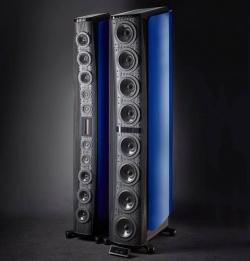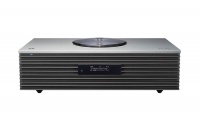Advanced Phase Precision Driver
To reproduce music with enhanced spatial sound expressivity requires that the wavefronts of sounds coming from the speaker unit are all aligned when they reach the listener regardless of the listening position. The concept of point sound source is one of the ideal approaches to achieve it.
To realise the point sound source reproduction, the coaxial configuration was adopted and then it was combined with the originally shaped Linear Phase Plug for aligning phases and the Smooth Flow Diaphragm formed with a shallow-shape diaphragm and smooth edge shape for minimum sound reflection.
The SB-G90M2’s 2-way coaxial speaker unit was newly developed for the reproduction of the mid- to high-frequency range in order to realise the clear sound image localisation and high sound quality to deliver smooth, emotion-rich music, while inheriting the concepts of point sound source and linear phase that Technics pursues relentlessly.
Linear Phase Plug
The originally shaped acoustic plug is positioned on the front side of the tweeter diaphragm and provides a high-resolution sound reproduction capability and a wide sound stage.
The tip of the Linear Phase Plug is made from a high-modulus, high-density brass material. It prevents the plug from vibrating unnecessarily due to the effect of the vibration of the mid-range unit, thus delivering clear and low-distortion sound.
Smooth Flow Diaphragm
When sound wave propagates along an irregular surface, its wavefront becomes disturbed due to the surface irregularities and results in the degradation of frequency characteristics.This affects particularly the characteristics of high frequencies with short wavelengths.
The diaphragm of the mid-range unit, which is part of the coaxial speaker unit, has a shallow shape with a smooth edge to reduce sound reflections so that the disturbance to the sounds radiated from the diaphragm is minimised, resulting in excellent frequency response, phase characteristic and wide directivity.
This configuration achieves a wide sound stage and smooth and rich mid- to high-frequency range.
Stationary Construction
To reproduce the sound of music with a high S/N ratio, sources of all undesirable or unwanted sound have been eliminated completely.
To that end, the balanced driver mounting architecture adopted by the previous SB-G90 model was further optimised through the extensive CAE analysis and the speaker mount baffle was newly developed for the secure mounting of the speaker units. In addition, the rigidity of the entire cabinet was strengthened to take advantage of the balanced driver mounting architecture. The strength and shape of each and every one of the parts composing the coaxial speaker was reviewed painstakingly in order to remove unwanted vibrations and noise as completely as possible. What’s more, a sound path structure is provided inside the cabinet. This new and unique structure effectively eliminate standing waves that cause a resonance peak.
Balanced Driver Mounting Architecture
Unwanted vibrations generated by the speaker mount baffle have been further reduced by improving the vent holes using CAE and by allowing the one-piece woofer amount baffle to penetrate the bottom board for achieving higher rigidity. What’s more, the optimised vent holes improve the distribution of sound radiated from the back sides of speakers for enhanced response. In addition, the coaxial speaker mount baffle is separated from the woofer mount baffle to eliminate the mutual interference.
Together, they further enhance the crispness of sound and three dimensional presentation of sound field.
Standing Wave Termination Structure
A resonance called standing wave is usually generated inside the speaker cabinet by the sound of a certain frequency determined by the cabinet size. The most common method to eliminate the standing wave is to install a sound absorbing material inside the cabinet. However, since sound absorbing material also absorbs sound at frequencies other than the one that generates a standing wave, it somewhat removes dynamism or vividness from the reproduced sound.
As a countermeasure, a sound path structure is provided at the bottom of the woofer cabinet to guide the standing waves. As a countermeasure, a sound path structure is provided at the bottom of the woofer cabinet to guide the standing waves. Sound absorbing material is installed at the location in the sound path where the speed of sound becomes fastest. This enables the efficient removal of standing waves, which are the cause of resonance peaks, with a minimum amount of sound absorbing material. (Patented)
This structure allows the use of all information necessary for accurately reproducing music so the speaker system realises more vivid and natural medium- and low-frequency sound.





